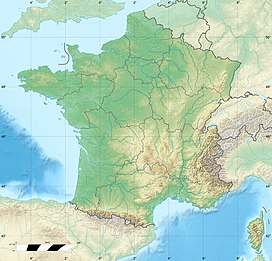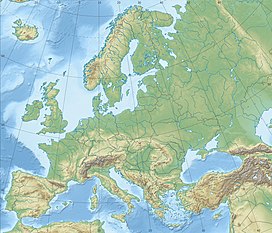
Back Mont Blanc Afrikaans Mont Blanc ALS ሞን ብላን Amharic Mont Blanc AN مون بلان Arabic جبل مون بلون ARZ Mont Blanc AST Monblan Azerbaijani Монблан Bashkir Mont Blanc BAR
| Mont Blanc | |
|---|---|
| Monte Bianco | |
 Mont Blanc from the Aosta Valley (Italy) | |
| Highest point | |
| Elevation | 4,805.59 m (15,766.4 ft)[1] |
| Prominence | 4696 m ↓ by Lake Kubenskoye Ranked 11th |
| Parent peak | Mount Elbrus[note 1] |
| Isolation | 2,812 km → Kukurtlu Dome[2] |
| Listing | Country high point Ultra Seven Summits |
| Coordinates | 45°49′58″N 06°51′54″E / 45.83278°N 6.86500°E |
| Geography | |
| Location | Aosta Valley, Italy Auvergne-Rhône-Alpes, France |
| Countries | France and Italy |
| Parent range | Graian Alps |
| Climbing | |
| First ascent | 8 August 1786 by |
 | |
Mont Blanc (BrE: /ˌmɒˈblɒ(k)/; AmE: /ˌmɑːn(t)ˈblɑːŋk/; French: Mont Blanc [mɔ̃ blɑ̃]; Italian: Monte Bianco [ˈmonte ˈbjaŋko], both meaning "white mountain") is the highest mountain in the Alps and Western Europe, and the highest mountain in Europe outside the Caucasus mountains, rising 4,805.59 m (15,766 ft)[3] above sea level, located on the French-Italian border.[4] It is the second-most prominent mountain in Europe, after Mount Elbrus, and the 11th most prominent mountain in the world.[5]
It gives its name to the Mont Blanc massif, which straddles parts of France, Italy and Switzerland. Mont Blanc's summit lies on the watershed line between the valleys of Ferret and Veny in Italy, and the valleys of Montjoie, and Arve in France. Ownership of the summit area has long been disputed between France and Italy.
The Mont Blanc massif is popular for outdoor activities like hiking, climbing, trail running and winter sports like skiing, and snowboarding. The most popular climbing route to the summit of Mont Blanc is the Goûter Route, which typically takes two days.
The three towns and their communes which surround Mont Blanc are Courmayeur in Aosta Valley, Italy; and Saint-Gervais-les-Bains and Chamonix in Haute-Savoie, France. The latter town was the site of the first Winter Olympics. A cable car ascends and crosses the mountain range from Courmayeur to Chamonix through the Col du Géant. The 11.6 km (7+1⁄4 mi) Mont Blanc Tunnel, constructed between 1957 and 1965, runs beneath the mountain and is a major transalpine transport route.
- ^ Beaumont, Peter (5 October 2023). "'Exceptional year': Mont Blanc shrinks by another 2 metres". The Guardian. ISSN 0261-3077. Archived from the original on 5 October 2023. Retrieved 5 October 2023.
- ^ Mont Blanc Archived 18 September 2020 at the Wayback Machine at peakbagger.com. Retrieved 19 August 2020.
- ^ Beaumont, Peter (5 October 2023). "'Exceptional year': Mont Blanc shrinks by another 2 metres". The Guardian. ISSN 0261-3077. Archived from the original on 5 October 2023. Retrieved 5 October 2023.
- ^ "Le mont Blanc a perdu un mètre en quatre ans et culmine désormais à 4807,81 mètres". Franceinfo (in French). 29 September 2021. Archived from the original on 29 September 2021. Retrieved 29 September 2021.
- ^ the prominence of 4,696 m for Mont Blanc is taken from the "Ultras Project" (peaklist.org Archived 9 January 2019 at the Wayback Machine), "List compiled 2004 by Petter Bjørstad, Jonathan de Ferranti, Eberhard Jurgalski, Vasja Kavcic and Aaron Maizlish". See also list of Alpine peaks by prominence.
Cite error: There are <ref group=note> tags on this page, but the references will not show without a {{reflist|group=note}} template (see the help page).
© MMXXIII Rich X Search. We shall prevail. All rights reserved. Rich X Search



